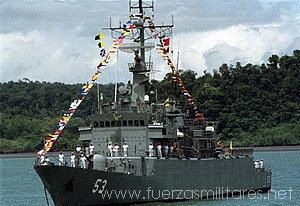Name ARC Antioquia Commissioned 29 March 1933 Refit 1954 Launched 9 June 1932 Draft 2.59 m | Acquired 1933 Decommissioned 23 January 1961 Fate Scrapped Length 98 m Builder Yarrow Shipbuilders | |
 | ||
ARC Antioquia was an Antioquia-class destroyer, the first ship of that name to serve the navy of Colombia, the Armada Nacional República de Colombia.
History
Antioquia was built in Lisbon, Portugal as a Douro-class destroyer for the Portuguese Navy (the Marinha Portuguesa), and originally named NRP Douro. The design of the six ships of the Douro class was by the British company Yarrow Shipbuilders, based on that of the Royal Navy's prototype destroyer HMS Ambuscade. Two were built at Yarrow's shipyard in Clydebank, Scotland, and the remaining four in Lisbon with Yarrow machinery. The name Douro had previously been applied in the Portuguese Navy to a destroyer, which served from 1914 to 1931, and was subsequently given to another destroyer (D332), commissioned from 1936 until 1959.
Douro was purchased before her completion by the Armada Nacional República de Colombia in 1933 in response to the Colombia–Peru War. She was renamed for Colombia's Antioquia Department, which had contributed the funds for her acquisition. A sister-ship, NRP Tejo, was purchased at the same time and renamed ARC Caldas. Collectively, the Colombian Navy called the two ships Antioquia-class destroyers.
In 1936 Antioquia was involved in what could have been a serious international incident.
On the occasion of the death of the British King, George V, the Bermuda Militia Artillery (BMA), a part-time reserve of the Royal Regiment of Artillery, had been instructed to fire a memorial salute from a 4.7 inches (120 mm) gun at St. David's Battery, in the British colony of Bermuda. This salute was to consist of seventy blank rounds, one for each year of the king's life, fired at one-minute intervals.
Because of the difficulty of storing ammunition in Bermuda's humid climate, there proved to be only twenty-three blank rounds in stock, and the remainder used were all headed ammunition. As the firing was to commence at 08:00 (on 21 January), and it was thought unlikely any vessels would be in the danger area, it was decided to proceed with the salute, ensuring the guns were elevated for maximum range (8,000 yards (7,300 m)), out to sea. The firing began at 08:00, and was over seventy minutes later.
What the BMA gunners were unaware of, however, was that Antioquia was at the receiving end of their barrage. Antioquia was under the command of a retired Royal Naval officer (part of the British Naval Mission to Colombia), and was arriving at Bermuda to undergo repairs at the Royal Naval Dockyard. Although the ship's crewmembers were alarmed to find themselves under fire, the ship fortunately was not hit.
ARC Antioquia and ARC Caldas were both refitted in the United States, at Mobile, Alabama, in 1954, when three 5 inches (130 mm) guns were fitted, two forward and one aft. This had the effect of shifting their centres-of-gravity, resulting in poor handling in foul weather, which also over-stressed the hulls.
Antioquia was decommissioned in 1961, when the name passed to a Fletcher-class destroyer, built in 1943 for the US Navy as USS Hale. The current ARC Antioquia is an Almirante Padilla-class missile-armed frigate.
